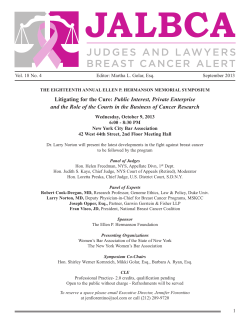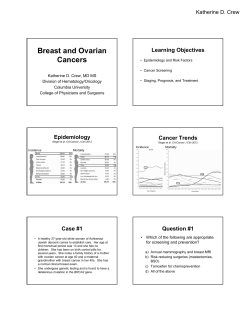
Document 15220
PATHOLOGISTS' CLUB
OF NEW YORK
I'O.ESII>e:<T
nQ> B. SMITH. M.D.
MEETING
DEJ'Alln.G'NTOPPA'nlOLOOY
ST. VIS<::ENT"$ HOSPrTAL.
U3 wt!ST llnl STRElrr
!'-"EW YORX. NY 10311
VICE PRl!$tD'ENT
DATE:
Thursday, June 4, 1998
PLACE:
Staten Island University Hospital
(North)
475 Seaview Avenue
Staten Island, NY I 0305
MODERATORS:
Karl Lanks, M.D., PhD.
Steven L. Goldberg, M.D.
INFORMATION:
Pat Fitzpatrick (718) 226-4130
JOAN G. lONEs , M.D.
ANATO~CPATHOUOOY
EINS'I'EIS·\\"'lll.ER UOSPITA1.
lllS P.AS'ICKI!S't'eR R.OAJ)
BllQe\"X, W'Y 16661
SEO.£l'AAY·Til.EAS\.I'JUJt
ST'\'1..1ANO& t.OWVAAnnJI. l4D
D£t~01' PA'niOf..OOY
ST. CI..AJt.E'$ HOim'AL
QS W'BT ~"D S'D.£21'
MEWYO~>N
lCDit
RECEPTION & DINNER: 5:15P.M. -7:00P.M.- Main Conference Room
S.I.U.H. -North
SCIENTIFIC SESSION:
DIRECTIONS:
7:00P.M.- 9:00P.M-
(SAME)
From the Verrazano-Narrows Bridge
Stay right as you enter Staten Island. Get off the
expressway at the South Beach exit, which wm leo.d you
onto Lily Pond Avenue. After a short distance, Lily Pond
becomes Father Capodanno Boulevard. Follow Father
Capodanno Boulevard to Seaview Avenue and tum right.
Look for the main hospital complex. Proceed to the next
block Mason Avenue tum right and go passed Seaview
Radiology and enter Parking Lot on right. (SEB
ATTACHED MAP FOR PARKING)
Please walk down Mason Avenue back to Seaview Avenue
and enter the Hospital at the Main Entrance and ask the
security desk to direct you to the Main Conference Room.
Case#lInvited Discussant: Dr. I~a Bleiwei.ss
Host Discussant:
Dr. Kok.ila Mody
35 year old women presented with left breast mass. Approximately 8 months ago she
noted progressive enlargement ofleft breast. She sought surgical attention where a fine
needle aspiration was perf0rrned, followed by left.breast biopsy. No history of hormonal
therapy or pregnancy. No family history of breast carcinoma.
Case #2Invited Discussant: Dr. Ira Bleiweiss
Host Discussant:
Dr. Steven Goldberg
51 year old women with slowly enlarging right breast over 5 years, now painful. The
involved breast was five times the size of the other breast :with discoloration of the lateral
and fiiferior sKin cifthe'breast measuring 'Zlx i'2 em. On mastectomy ihenr was a- - 24xl9xl4.5 em well circumscribed rubbery white mass with occasional 0.3 to 0.6 em.
cysts filled with brownish fluid.
Case #3
Invited Discussant: Dr. Peter Kozlowki
Host Discussant:
Dr. Monika Wrzolek
37 year old man developed new onset of grand mal seizures. CT scans of the head
revealed left frontal extra axial mass with peritumoral edema and shift to the right.
Physical examination and preoperative work-up were unremarkable. Patient underwent
gross total resection of the tumor. Postoperative course was uneventful. The specimen
consisted of a 3.3x3x2.1 em. firm yellow-tan dura-based mass.
Case#4
Invited Discussant: Dr. James Woodruff
Dr. Lynn Opitz
Host Discussant:
19 year old man with a left sided, non painful neck mass for approximately six months to a
year. The surgeon stated that the mass was deep seated in the lower neck and associated
with the brachial plexus. The lesion was a pale tan, circumscribed mass measuring
8.4x4.5x3 cm se"veraffirm lymph nodes we re also-suomitteo along witht he r.iass. - - -Case#S
Invited Discussant: Dr. Victor Vigorita
Host Discussant:
Dr. Steven Goldbe;g
26 year old male with progressive lower back pain for 6 months associated with right
lower extremity radiculopathy. Work up showed a lytic central expensile deformity of the
right L4 facet and medial laminar. The lesion was removed piecemeal fashion.
PATHOLOGISTS'
CLUB
.
OPNEWYORK
tt!SI:DDn
~ANO, JONES, M.D.
A)IA.1"Qt...C PAn•OU.XiY
mmtr:LY."EEL!lt HOSI'fTAL
1125 EASTOD!ST'!Il WAD
BRO.\{X, H'V tt>41i I
""' fUSIIlEMT
S'TYLW40S LOMVA.M.DW, M.D
ST. CJ..AA.E'SUOSPITAL.
.c%6 W1!ST S%..""1> STR.EET
~ Y<likK,. );y IOOif
SECJUi.TAAY·Tl\£ASVR.Ek
11'AI.TU8L.UMENFEL.D. MD.
'Wt!mtkOP UMVD.SITY NOSPITAL
m STATtml PLAZA N()flnt, SI,I'I'T'E tl a
ML\ffiOt.A., NY I U l>l
MINUTES OF MEETING
June4, 1998
Staten Island University Hospital
This meeting was the first one the Club has held on Staten Island and Dr.
Smith thanked Dr. Lanks and Dr. Goldberg for hosting on rather short notice.
The total attendance of 42 was gratifying. As was announced at the May
meeting, elections were held with the following results: Dr. Joan Jones,
President, Dr. Lomvardias, Vice President and Dr. Walter Blumenfeld,
Secretary-Treasurer. Dr. Goldberg moderated the scientific session.
Case 1. 35 year old woman with progressive enlargement of left breast for 8 months. Fine needle
aspiration was followed by biopsy.
Guest discussant: Dr. Ira Bleiweiss, Mt. Sinai Med. Center
Host: Dr. Kolcila Mody
Abnormalities are confined to the stroma, which exhibits focal hyalinization and narrow spaces
suggesting disappearing vessels. The latter do not contain erythrocytes, and do not show
anastomosing pattern and atypia. Although immunohistochemistry is not needed for interpretation
of a case such as this, for the sake of discussion a few stains were performed. Vimentin stains the
stromal cells. Lack of reactivity with factor VITI confirms that cells in these spaces arc not
endothelial. Some cells stain with CD34 but probably these are not cells in the spaces.
Pseudoangiomatous stromal hyperplasia (PASH) generally occurs in fibrocystic change or
hamartoma, but in some cases it presents as a mass. The only other remote possibilities include
angiosarcoma or the even more rare angiomatosis. One important question here is whether this is
the only abnormality or merely a component of some other lesion. In Dr. Rosen's series of 40, two
stained for ER, five for PR and two for both, implying that they arc hormonally responsive. Dr.
Mody reported that the clinical diagnosis was of a malignancy. She demonstrated the striking
mammographic appearance of a diffuse homogeneous density. The entire right breast was finn,
nontender and three times larger than the left. Secondary changes consisted of venous dilatation
and of thickened skin. On section, parenchyma was rubbery and lobulated.
Dx: Pseudoangiomatous hyperplasia of the breast
J. Powell CM et al: Pseudoangiomatous hyperplasia... AmJSurgPath 19: 270, 1995
2. Anderson C eta!: Immunocytochemical analysis of estrogen... AmerJSurgPath 15: 145, I 991
3. Vuitch MF eta!: Pseudoangiomatous... Hum Patholl7: 185, 1986
2
Case 2. 51 year old woman with five year history of slowly enlarging breast to five times the size
of the opposite. The 24x19x14.5 em mastectomy consisted of a demarcated rubbery white mass
with fluid filled cysts up to 0.6cm across.
Guest discussant: Dr. Ira Bleiweiss
Host: Dr. Steven Goldberg
Tn addition to fibrocystic change there are foci of edematous, perhaps myxoid, degeneration of the
stroma and spindle-shaped ceiJs arranged in fascicles. Other foci resemble the smooth muscle cells
normally investing nipple ducts, some occur in fascicles, some in association with adipose tissue
and with epithelial cells (ducts). Some of the stromal cells appear epithelioid, although this could
be an artifact of the cross-section appearance. CeiJ markers are very useful: reactivity to desmin
proves this is in fact smooth· muscle. Myoepithelial cells fail to react, therefore this tumor is not of
myoepithelial origin. S 100 and cytokeratin stains are negative. Cells stain with both ER and PR.
The differential includes myoid hamartoma, hamartoma, fibroadenoma with smooth muscle (but it
lacks the pattern of fibroadenoma), leiomyoma and leiomyosarcoma It lacks a malignant
appearance, and it is not a pure leiomyoma Other stromal and rare tumors that are easily excluded
are malignant phyllodes tumor, carcinosarcoma and metaplastic carcinoma The problem with these
tumors arises when the smooth muscle cells have assumed an epithelioid form. Dr. Bleiweiss
emphasized that to identify benign conditions in the breast one must be aware that they exist, and
must correlate morphology with clinical and radiographic data If a core biopsy is taken, as is the
case when lesions are small and the surgeon prefers not to excise an apparently benign small lesion,
careful correlation is essential. Aspiration will not be useful, as it yields minimal material. Core
biopsy has proven to be more advantageous: besides allowing a d illb'llOSis, it facilitates planning of
surgery, following new abnormalities after biopsy and irradiation, and avoiding surgery for benign
lesions. Numerous levels of core biopsies are desirable, and if the diagnosis is in doubt, excision
should be suggested. Dr. Bleiweiss offered the following guidelines for core biopsies:
I. Mass on mammogram: look at the images: an adequate core goes entirely through the lesion.
2. Calcifications: correlate with the images. Examine many levels so as to find all depositS and
communicate with the radiologist. 3.lfit is fibrofatty and the radiologist is certain he sampled it, it
might be a hamartoma and should be followed. 4. Ifthe only finding is apocrine metaplasia and the
lesion "disappears', it is a benign cyst and should be followed. 5. Lactational change indicates a
lactational adenoma 6. Ifa papilloma is found and the radiologist reports "shrinking" on fullow-up
mammogram, the diagnosis should be papillary lesion and it should be excised. Dr. Goldberg
agreed with this interpretation. Myoid hamartoma was described by Daroca in 1985. Dr. Rosen
states that it always occurs with sclerosing adenosis and suggests it may not be a true entity. The
mammogram shows diffuse homogeneous density, sharply circumscribed. Interpretation of the
sonogram offered the diagnosis of sarcoma. The skin was mottled with both hyper- and
bypopigmentation, and the areola was greatly expanded. The cut surfuce resembled fibrocystic
change but it was circumscribed. There was secondary PASH. Large areas of degeneration
contained fluid. Stain for smooth muscle actin was positive. After five years of enlargement, the
patient agreed to mastectomy.
Dx: Myoid hamartoma of the breast
I. Daroca PJ et al: Myoid hamartoma of the breast. HumPathol 16: 212, 1985
2. Garfein CF et al: Epithelioid cells in myoid hamartoma... Arch Pathol Lab Med 120: 676; 1996
3
Case 3. Grcllld mal seizures in a 37 year old man led to discovery and removal of a left frontal
extra-axial tumor. Periturnoral edema and shift to tbe right were noted. The 3.3x3.2x2.l em tumor
was flfiD, yellow and dura-based.
Guest discussant: Dr. Peter Kozlowski, lnstitute for Brain Research
Host: Dr. Monika Wrzolek
Dura-based tumors are meningiomas unless otherwise shown, as in the very rare lymphoma,
plasmacytoma, etc. Stains for microorganisms are negative. On a background of scattered palestaining cells, there are some lymphoid cells, sometimes in clusters, and plasma cells, the latter
being polyclonal. EMA stains plasma cells but none of the other cells. Tbe pale cells are poorly
demarkated histiocytes, some with small, others with huge nuclei. Some are in close proximity to
small lymphocytes. This formation stands out m_ore clearly with the S-1 00 stain. This
manifestation of emperipolesis is found in a variety of conditions: plasmacytoma, syphilis,
tuberculosis, rheumatoid arthritis, sarcoid, Castleman's DiSease, xanthoma, Langerbans' cell
histiocytosis, Rosai-Dorfman disease, and plasma cell granuloma The differential diagnosis lies
between the last two states. Plasma cell granuloma is very rare in the dura, it lacks emperipolesis
and bas variable fibroblastic reaction. Rosai-Dorfinan, (extranodal histiocytosis with massive
lymhadenopathy. In the CNS it may be intra- or epidural, single or muhiple, and appears in the first
tv.'O decades. About 90"/o present with painless bilateral cervical lymphadenopathy, polyclonal
increase in immunoglobulins, leukocytosis and anemia. Dr. Wrzolck presented the Cf image,
demonstrating sharp demarkation from the brain, but with focal extension into the grey matter. She
pointed out the storiform pattern of fibrosis and the typical perivascular clustering of plasma cells.
In the differential one should include meningioma with prominent plasmacytic infiltrate. Of twenty
CNS cases one half had no nodal disease, but had other extranodal sites also. Stains for CD! and
Leu8 are negative.
Dx: Sinus histiocytosis with massive lymphadenopathy (Rosai-Dorfrnan disease)
I. Song SK et al: Meningeal nodules ... AmJSurgPath 13: 406, 1989
2. Wenig BM et al: Extranodal sinus histiocytosis....Hurn Pathol 24: 483, 1993
3. Montgomery EA et al: Rosai-Dorfinan disease of soft tissue ... AmJSurgPath 16: 122, 1992
Case 4. Painless mass deeply in the left lower neck, associated with the bmcbial plexus of a 19 year
old man. It was pale tan, 8.4x4.5x3cm, circumscribed and associated with firm lymph nodes.
Guest discussant: Dr. James
Host: Dr. Lynn Opitz
Woo~
Memorial Sloan-Kettering
Dr. Woodruff noted the lesion is multi focal with fat at the edges, and with irregular clustering of
cells around slit-like vessels. Some cells form ribbons. Nuclear hyperchromasia leaves no doubt
this is a tumor. Cells lie under the endothelium, are uniform in size and shape, without prominent
nucleoli. Differential diagnosis includes epithelioid hemangioendothelioma, glomus tumor,
sclerosing paraganglioma, sclerosing synovial sarcoma and solitary fibrous tumor. Absence of
staining with CD31 and CD34 excludes epithelioid hemangioendothelioma. Glomus tumor presents
..
4
as blue-red nodules deep in the dermis or subcutis on the extremities of young females. ln this ease,
desmin, SMA and MCA stains are negative, therefore this is not a smooth muscle tumor. Electron
micrographs reveal round and ovoid cells, surrounded by basement membrane. Cytokeratin CD34
and cbromogranin stains are negative, S- 100 equivocal. Lack of reaction with CK and EMA
sxcludes sclerosing synovial sarcoma. In solitary fibrous tumor, cells are spindly, not epithelioid.
Four types ofHPC are recognized: a conventional, b. myxoid, c. sclerosing, d. lipomatous. On
e.lectron microscopy there is no smooth muscle differentiation. Enzioger and Weiss propose 4
mitoses per HPF as the cutoff for malignancy, but some cases thus classified as benign eventuate in
death. It is very difficult to predict prognosis. Dr. Opitz reported that the patient is well three years
after surgery. Cytogenetic analysis has revealed that this twnor is characterized by a 12q (22)
translocation.
1.
2.
3.
4.
Nielsen GP et a!: Lipomatous bemangiopericytoma ... AmJSurgPath 19: 748, 1995
Perry Aet al: lmmunopbenotypic spectrum.... AmJSurgPath 21: 1554, 1997
Perez-Atayde AReta!: Hemangiopericytoma of the tongue. HurnPath25: 425, 1994
Nappi 0 et al: Hemangiopericytoma ...SeminDiagnPathol 12:221 , 1995
Case 5. 26 year old man with progressive lower back pain and right leg radiculopathy for six
months. A lytic central expansile lesion of the right L4 fucet and medial lamina was removed
piecemeal.
Guest discussant: Dr. Vincent Yigorita, Lutheran Medical Center
Host: Dr. Steven Goldberg
Dr. Yigorita began by emphasizing that the diagnosis cannot be based on morphology: the
radiographic appearance is critical. The differential is between osteoid osteoma and osteoid
osteoblastoma Punctate radiodensities may reflect either calcification in cartilage or bone
formation. Size is also critical: is it over 2cm? There is no developing bone sclerosis on Xray.
Bone formation well demarkated from host bone is typical for osteoid osteoma, but may be found in
osteoblastoma. There are also foci of bland hypervascular tissue. Symptoms of osteoid osteoma
consist of pain greater at night, not relieved by rest, and localized swelling, so it may present as
arthritis. Typically it occurs in the leg. Osteoblastoma is more common in the spine, with
thickened cortex, central lucency (nidus) and with bone formation in the center. Osteoid osteoma is
well circumscribed, embedded in the cortex and has limited growth potentia~ leading some
authorities to stale that it is not a neoplasm. It may be quite difficult to localize in the specimen,
given its si.ze of only a few millimeters. It is not unusual to find it only after two or three
operations. Injections of technetium or tetrncycline before.surgery facilitates excision. There is
some overlap between Osteoid osteoma and osteoblastoma around the 2cm limit, and also between
aggressive ostcoblastoma and osteogenic sarcoma in larger tumors. Histologic distinction is not
possible, especially as they occur in the same age group. Aspirin relieves pain in osteoid osteoma.
Osteoblastoma continues to grow and shows no or mild sclerosis oo Xray. Treatment for the latter
is removal with an adequate margin. Dr. Goldberg reported that the radiographic interpretation
suggested aneurysmal bone cyst as well as osteoid osteoma,
Ox: Giant osteoid osteoma (osteoblastoma).
!. Yigorita VJ eta!: Localization of osteoid osteomas... AmerJClinPath 79: 223, 1983
2. Healy JH et al: Osteoid osteoma... CiinOrthopRelatResearch 204: 76, 1986
© Copyright 2025





















